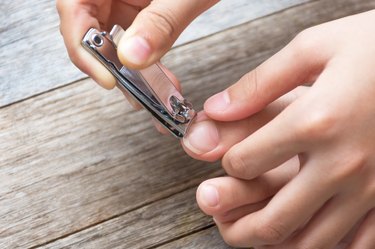
Ugh, the agony of an ingrown toenail. All that toe redness, swelling, pain and (perhaps) pus around your toenail is all because the corner of the nail grew down into the skin.
Painful ingrowns can happen for a bunch of reasons, including shoes that are too tight, your specific foot shape or if you stubbed your toe on something really hard, per the Cleveland Clinic. But one of the most common causes is — thankfully — one you can prevent: Cutting your toenails wrong.
Video of the Day
Video of the Day
Toenail trimming rule number one: Avoid a super-short round shape.
"When a nail is cut in a curved shape, it has the tendency to grow inward as opposed to straight out. That causes uneven pressure on the sides of the nails, causing the nails to harden due to the impact of walking, tight shoes or tight socks," Marcela Correa, licensed medical pedicurist and founder of Medi Pedi NYC, tells LIVESTRONG.com. "The harder and deeper the nail gets, the more painful it is to apply pressure to the area."
How to Prevent Ingrown Toenails
The best shape for nails, Correa says, is "straight across, round corners."
"That's the best shape for any nail condition, whether nails are fragile or thick. This shape allows the nails to grow out straight, preventing them from digging or causing an ingrown nail," she says.
Follow her tips for trimming toenails correctly:
1. Trim Post-Shower
Dry nails are more prone to cracks.
"Trimming after the shower is best, as your nails will be softer and easier to manage," Correa says.
If your nails are especially thick and give you trouble when you trim, then soak them for 20 minutes with a foot soak. Correa likes Truremedy Naturals Funga-Free Foot Soak.
2. Always Use Clippers
It's oddly satisfying to rip off a nail, but tearing your nails also makes them prone to ingrowns.
Clippers designed for toenails tend to be larger and grip better, a plus when you need to "control the direction and depth in which you're cutting your nails," Correa says.
Smaller fingernail clippers used on toenails increase the chance for clipping mistakes. Correa prefers using a "nipper." "These are stronger and larger, providing more room to cut a thick nail," she says.
3. Don’t Go Too Short
Going too short is a common mistake that makes you prone to nail problems. Be especially careful with the big toenail, because this is the number one place for an ingrown.
How often you trim them depends on just how fast your nails grow, but it should be about every three to four weeks, Correa says.
4. Cut Straight Across
Cut the nail straight across with a clipper. Then, file it back and forth straight until you reach your desired length.
5. Address the Edges
With the nail file, round the corners enough to remove any sharp edges or points. The important thing is that the nail is not rounded below the flesh line. (You should be able to get your fingernail under the end of the toenail, notes Harvard Health Publishing.)
How to Treat an Ingrown Nail
If you have an ingrown, you can treat it by soaking your foot three times a day in warm water, sporting comfy shoes and keeping the foot dry (at other times of the day), suggests the American Academy of Orthopaedic Surgeons.
But, if things don't begin to heal in a few days, you'll have to call your doctor for treatment, which, depending on how bad the situation is, might require antibiotics to clear up an infection or removing part of the nail (only a doctor should do this for you).
People who have certain medical conditions, like diabetes or circulation problems, are at an increased risk for foot problems like ingrowns. Talk to your doctor about any foot problem before treating it yourself.
Was this article helpful?
150 Characters Max
0/150
Thank you for sharing!
Thank you for your feedback!
Is this an emergency? If you are experiencing serious medical symptoms, please see the National Library of Medicine’s list of signs you need emergency medical attention or call 911.